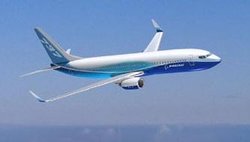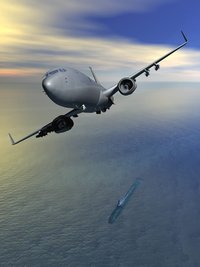Boeing 737
|
|
The Boeing 737 is a popular short-to-medium range commercial passenger jet aircraft. It has been continuously manufactured by Boeing Commercial Airplanes since 1967. With 5,000 sold, it is the most-produced commercial passenger jet aircraft of all time.
| Contents |
History
The 737 was born out of Boeing's need to field a competitor in the short-range, small capacity jetliner market which had been opened up by the BAC 1-11 and the Douglas DC-9. Boeing was badly behind however when the 737 program was initiated in 1964, as both of these rivals were already into their flight certification programmes. To speed up the development time, Boeing reused as much technology from the existing 707 and 727 as possible, most notably the fuselage. This gave the 737 a critical advantage over the opposition - six abreast seating compared to the 1-11 and DC-9's five abreast layout, and also made the 737 cheaper and quicker to design. But the decision also dated the design, and created problems for future modernisation, which still haunts the current Next Generation series to this day.
Astraeus.commons.b737-300.g-stra.arp.2.jpg
The short and stubby appearance of the first 737-100 earned it the nickname among Boeing engineers as "FLUF", being an acronym for "Fat Little Ugly Fella", although the industry affectionately called it the "Baby Boeing".
The -100 and -200 series are identifiable by their tubular engine nacelles which are integrated into the wing and project both fore and aft of it. The engines used on the Original 737 models are Pratt and Whitney JT8D turbofans. The Originals can also be identified by the smoothly curving upsweep of the tail fin - the Classics and NG models have a noticeable "kink" at the base of the fin.
The first 737 (a 100 series) took its maiden flight April 9, 1967 and entered service in February 1968 with Lufthansa, the first foreign airline to launch a new Boeing plane. The 737-200 made its maiden flight on August 8, 1967. Lufthansa was the only customer to purchase the 737-100 from new and only 30 aircraft were ever produced. The lengthened 737-200 was widely preferred and was produced until 1988. The launch customer of the 737-200 was United Airlines.
Boeing_737_cockpit.jpg
In the early 1980s the 737 had its first major facelift. The biggest change was to the CFM International CFM56 engines in place of the JT8Ds. The CFM56 was larger than the previous P&W unit, so the engine was slung underneath the wing rather than built into it. This posed a problem as the 737's limited ground clearance (a trait of the 707-derived fuselage) meant that the bottom surface of the engine nacelle had to be flattened out. At the same time, the 737 gained a partial glass cockpit from the 757 and 767. The first 737-300 entered service in 1984.
By the 1990s, the 737 had lost ground technologically to the newer Airbus A320. In 1993, Boeing initiated the 737-X or Next Generation (NG) programme.
The Next-Generation 737 encompasses the -600, -700, -800 and -900, and amounted to what was a complete redesign of the 30-year old airliner.
New wings, new avionics and revised engines were the biggest engineering changes. The 737 was given a hi-tech glass cockpit with LCD screens and digital systems heavily inspired by that used on the 777. An all new interior was designed for the Next-Generation 737, again borrowing heavily from the 777. The 737NG is an entirely new aircraft, sharing very little with previous 737s, other than fuselage frames. The parts count is down by about 33%, reducing weight and simplifying maintenance greatly. Additional changes since its introduction include a new interior and performance enhancing winglets which reduce fuel consumption and improve take-off and climb performance. Boeing stopped short however of retrofitting fly by wire as used on the A320 on the grounds of cost.
In 2001, the 737 was stretched one more time to create the 737-900, which is in fact longer and carries more passengers than the 707, and steps into the capacity of the 757-200. As a result of weak demand Boeing closed the 757 line in 2004. Early in 2005, the 737 lost its distinctive "eyebrow" windows in the cockpit - once a requirement in the 1960s for added taxiway visibility but now deemed unnecessary, and a retrofit kit will be offered to remove the windows on existing aircraft.
Boeing is rumored to be working on a higher capacity version of the 737-900, the extra seats being made possible by adding more exit doors. However, with the 737's basic design now approaching 40 years old, and with the fuselage having already been stretched to its absolute limit, it is clear that further updates will follow the law of diminishing return. Boeing has already hinted that a clean sheet replacement for the 737 will be the company's next major project after the 787, although it is still unclear if the existing 737 will receive yet one more facelift in the next 7 to 10 years.
Variants
There have been three basic generations of the 737, known as the Original, Classic and Next-Generation (NG) models.
- Original: the 737-100 and -200 (Produced from 1967 - 1988)
- Classic: the 737-300, -400, and -500 (Produced from 1983 - 2000)
- Next-Generation (or 737NG): 737-600, -700, -800, and -900 (Produced from 1997 - )
Some versions in different generations correspond to each other in size. These are:
- 737-100 — Smallest, original layout
- 737-200 — Extended version of the -100 in order to accommodate the US market
- Subvariants include:
- 737-221 (Pan American World Airways)
- 737-222 (United Airlines)
- 737-233 (Air Canada)
- 737-2B7 (USAir)
- 737-500, 737-600 — Shortened versions of the -300 and -700 respectively
- 737-300, 737-700 — The new base models, slightly stretched over the 737-200
- 737-400, 737-800 — Stretched versions mostly to accommodate charter and business airlines
- 737-900 and 900X — Recent versions stretched even further to close a gap in Boeing's product line-up
- 737-700IGW, 737-800ERX — These variants have been awarded military contracts (see Military variants below), but the specifications have not yet been found for this encyclopedia entry.
When referring to variants of the 737, Boeing and the airlines often collapse the model (737) and the capacity designator (-300, -800, etc.) into a smaller form, either 733 or 738. The exception is the 737-700, which is abbreviated as 73G, in order to avoid confusion with the model number itself. These notations may be found in aircraft manuals or airline timetables.
Also in production is the Boeing Business Jet (BBJ and BBJ2). The BBJ is based on the 737-700 but is fitted with the stronger wings from the 737-800, while the BBJ2 is based upon the 737-800. The BBJ has increased range (by use of extra fuel tanks) over the other 737 models and is currently operated by some airlines on premium flights between North America and Europe.
The vast majority of 737s in commecial revenue service are the Classic and NG models - the Original models are quickly heading for extinction owing to poorer fuel efficiency, high noise emissions (despite the vast majority having had their JT8Ds fitted with hush kits) and escalating maintenance costs - although a large number of -200s are still in operation with "second tier" airlines and those of developing countries. No 737-100 remains in airworthy condition; however the original Boeing prototype (now owned by NASA) is now exhibited in the Museum of Flight in Seattle.
Military variants
There are several versions of the 737 with special duties.
- T-43, a 737-200 - Used to train aircraft navigators for the U.S. Air Force.
- C-40 Clipper, a 737-700 - The U.S. Navy's replacement for the C-9 Skytrain II.
- Project Wedgetail, a 737-700IGW - This is an AEW&C version of the 737NG. Australia is the first customer, with Turkey, South Korea, and Italy anticipated.
- Multimission Maritime Aircraft (MMA), a 737-800ERX - On June 14, 2004, Boeing's Integrated Defense Systems division beat Lockheed Martin in the contest to replace the P-3 Orion maritime patrol aircraft. Eventual orders will probably exceed 100 from the U.S. Navy alone, with other orders from foreign navies certain to follow.
General characteristics
- Cruise speed: Mach 0.74 , 420 knots (780 km/h) (Original & Classic)
- Cruise speed: Mach 0.78, 440 kt (815 km/h) (NG)
- Propulsion: Two High Bypass Ratio turbofan engines, rated at between 64.4 kN and 117.3 kN each
- Maximum range:
- 3,050 nautical miles (5,650 km) (600)
- 3,060 nautical miles (5,670 km) (700, 800)
- 2,745 nautical miles (5,080 km) (900)
- Wingspan: between 93.0 ft and 112.6 ft (28.3 m and 34.3 m) (36 m for winglet -700, -800, -900)
- Length:
- 102.5 ft (31.2 m) (600)
- 129.5 ft (39.5 m) (700, 800)
- 138.2 ft (42.1 m) (900)
- Tail height:
- 41.3 ft (12.6 m) (600)
- 41.2 ft (12.5 m) (700, 800, 900)
- Maximum takeoff weight:
- 143,500 lb (65,090 kg) (600)
- 174,200 lb (79,010 kg) (700, 800, 900)
- Capacity: 85 to 189 passengers
- Cost: USD $44 million to $74 million list price in 2004 [1] (http://www.boeing.com/commercial/prices/)
- Autoflight, Displays, Navigation and Sensors by Honeywell
- Section 41, fuselage, and most other components produced in Wichita, Kansas. Final assembly is in Seattle-Renton, Washington.
Accidents summary
- Hull-loss Accidents: 108 with a total of 2802 fatalities
- Other occurrences: 6 with a total of 242 fatalities
- Hijackings: 96 with a total of 325 fatalities
Related content
Related development
Similar aircraft
See also
External links
- http://www.b737.org.uk/
- Aircraft-Info.net - Boeing 737-400 (http://www.aircraft-info.net/aircraft/jet_aircraft/boeing/737-400/)
- Download Boeing 737 for Flight Simulator (http://flyawaysimulation.com/downloads-file-321-details.html)
- Planemad.net - Boeing 737 all versions Production Lists (http://www.planemad.net/data/list/Boeing/737/)
- The Boeing 737 Management Reference Guide (for B737 airline pilots) (http://www.b737mrg.net/)
- Official Boeing page (http://www.boeing.com/commercial/737family/background.html)
- List of 737NG operators (http://www.speednews.com/lists/737NG.html)
|
Lists of Aircraft | Aircraft manufacturers | Aircraft engines | Aircraft engine manufacturers Airports | Airlines | Air forces | Aircraft weapons | Missiles | Timeline of aviation |
de:Boeing 737 et:Boeing 737 es:Boeing 737 fr:Boeing 737 id:Boeing 737 nl:Boeing 737 ja:ボーイング737 pt:Boeing 737 sv:Boeing 737


